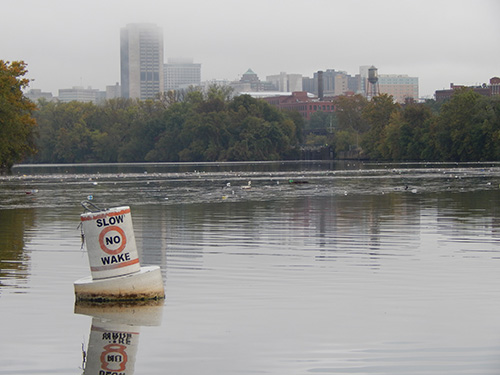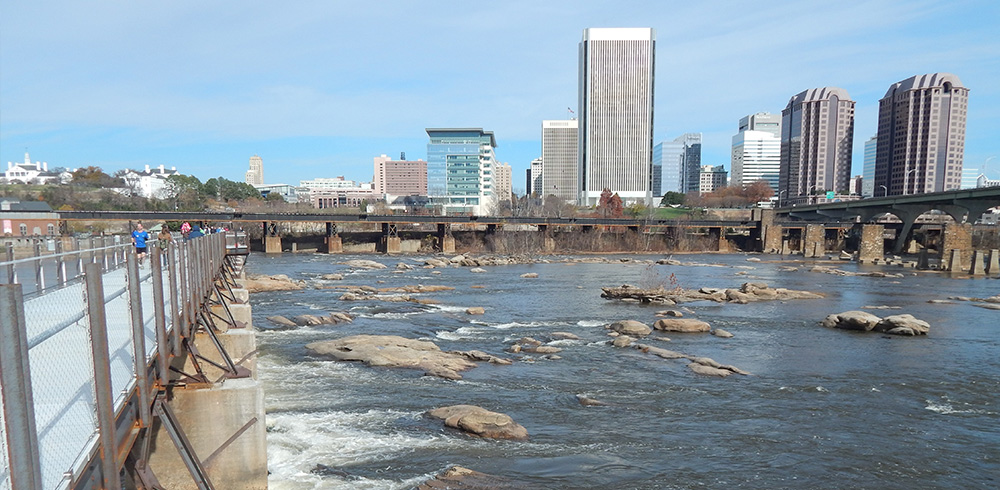While running for Mayor of the City of Richmond Levar Stoney stated, “It is 2016, not 1816. We should not be worried about clean water for our citizens. This needs to be a public health and an environmental priority.” This statement refers to Richmond’s combined sewer system, an archaic system that conveys pollution to the James River after significant rainfall events. Mayor Stoney’s Proposed Capital Improvement Plan for Fiscal Years 2020 – 2024 includes funding for projects that will reduce pollution entering the river via the combined sewer system.
How do combined sewer systems work?
During dry weather conditions, wastewater is piped to Richmond’s wastewater treatment plant to be treated before returning to the James River. During wet weather conditions, stormwater enters the combined sewer system via storm drains. If stormwater overwhelms the system’s capacity, stormwater and wastewater overflow directly into the James River and Gillies Creek. Combined sewer overflows typically occur following heavy rainfall and the release of stormwater combined with untreated wastewater contributes to poor water quality and impairs recreational use of the river. Richmonders can subscribe to receive automated email alerts whenever a combined sewer overflow occurs.

The strategies listed below help reduce the frequency of combined sewer overflows.
- Separating stormwater from wastewater. Keeping stormwater out of the combined sewer system is a strategy for reducing the frequency of combined sewer overflows and Richmond has made progress separating its system.
- Increasing storage capacity. Underground tunnels like Washington, D.C.’s recently constructed Anacostia River Tunnel and retention basins like Richmond’s Shockoe Retention Basin can hold polluted water to give wastewater treatment plants time to treat wastewater and stormwater in combined sewer systems. The Shockoe Retention Basin located on Chapel Island can hold 50 million gallons of untreated wastewater and stormwater.
- Wastewater treatment plant upgrades. With increased wastewater treatment capacity comes fewer combined sewer overflows. Richmond’s wastewater treatment plant can treat 75 million gallons of water per day and the City is expanding its treatment capacity. The wastewater treatment plant reduces the amount of nutrient and sediment pollution entering the James River.
- Green infrastructure. Planting trees and shrubs, constructing greenways, and installing other green infrastructure features that absorb rainfall reduces the volume of stormwater entering the combined sewer system. Numerous green infrastructure projects are underway or being planned across the City and include the Low Line, Jefferson Avenue, and Gillies Creek Greenway.
- Public outreach and long term planning. Helping everyone understand what they can do to contribute to a healthy James River is important. In 2014, Richmond launched the RVA H2O initiative with the goal of achieving “cleaner water faster” through outreach and education and by fostering stakeholder collaboration. The City released the RVA Clean Water Plan in 2017 and aligned the management of Richmond’s water systems under a single permit program for keeping the James River pollution free.
Since becoming Mayor of Richmond in 2017, Mayor Stoney and his administration have been champions of a healthy James River. Mayor Stoney’s Proposed Capital Improvement Plan for Fiscal Years 2020 – 2024, presented to City Council earlier this month, includes more than $21 million for projects that will contribute to a healthy James River.
- $15,006,000 for Stormwater Facilities Improvements
- $3,984,000 for Wastewater Treatment
- $2,323,000 for Combined Sewer Overflows
- $210,000 for Gillies Creek Greenway
- $150,000 for Jefferson Avenue
- $115,000 for Low Line Phase III, also known as “Low Line Green”
The James River Association supports funding for stormwater, wastewater, and green infrastructure projects included in Mayor Stoney’s proposed FY 2020 – 2024 Capital Improvement Plan. Residents of the City of Richmond can contact their councilmembers and encourage them to support projects that contribute to a healthy James River.
Help the James River Association advocate for a healthy and accessible James River by joining our Action Network.

